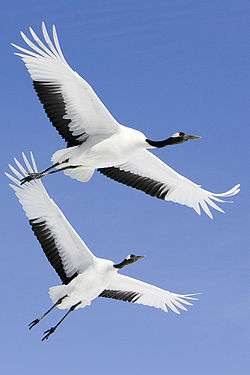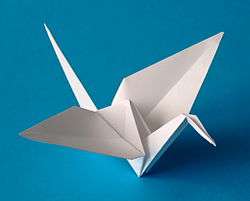Definify.com
Definition 2025
鶴
鶴
Translingual
Han character
鶴 (radical 196 鳥+10, 21 strokes, cangjie input 十土竹日火 (JGHAF) or 人土竹日火 (OGHAF), four-corner 47227, composition ⿰隺鳥)
References
- KangXi: page 1496, character 20
- Dai Kanwa Jiten: character 47185
- Dae Jaweon: page 2026, character 10
- Hanyu Da Zidian: volume 7, page 4654, character 3
- Unihan data for U+9DB4
Chinese
| trad. | 鶴 | |
|---|---|---|
| simp. | 鹤 | |
Glyph origin
| Characters in the same phonetic series (寉) (Zhengzhang, 2003) | |
|---|---|
| Old Chinese | |
| 鶴 | *ɡloːwɢ |
| 髉 | *pqroːwɢ |
| 篧 | *skroːwɢ, *sɡroːwɢ |
| 榷 | *kroːwɢ |
| 搉 | *kroːwɢ, *kroːwɢ, *kʰroːwɢ |
| 傕 | *kroːwɢ |
| 確 | *kʰroːwɢ |
| 寉 | *ɡluːwɢ |
| 蒮 | *luwɢ |
Phono-semantic compound (形聲, OC *ɡloːwɢ) : phonetic 隺 + semantic 鳥.
Pronunciation
- Mandarin
- Cantonese (Jyutping): hok6
- Min Dong (BUC): hŏk
- Min Nan (POJ): ho̍h
- Wu (Wiktionary): ngoq (T5)
- Mandarin
- (Standard Chinese, Mainland and Taiwan)+
- Pinyin:
- Zhuyin: ㄏㄜˋ
- Wade-Giles: ho4
- Gwoyeu Romatzyh: heh
- IPA (key): /xɤ⁵¹/
- (Standard Chinese, variant in Taiwan)+
- Pinyin:
- Zhuyin: ㄏㄠˋ
- Wade-Giles: hao4
- Gwoyeu Romatzyh: haw
- IPA (key): /xɑʊ̯⁵¹/
- (Standard Chinese, Mainland and Taiwan)+
- Cantonese
- (Standard Cantonese, Guangzhou)+
- Jyutping: hok6
- Yale: hohk
- Cantonese Pinyin: hok9
- IPA (key): /hɔːk̚²/
- (Standard Cantonese, Guangzhou)+
- Min Dong
- (Fuzhou)
- Bàng-uâ-cê: hŏk
- IPA (key): /houʔ⁵⁵/
- (Fuzhou)
- Min Nan
- (Hokkien)
- Pe̍h-ōe-jī: ho̍h
- Tâi-lô: ho̍h
- Phofsit Daibuun: hoih
- IPA (Xiamen): /hɤʔ⁴/
- IPA (Quanzhou): /hɤʔ²⁴/
- IPA (Zhangzhou): /hɤʔ¹²¹/
- IPA (Taipei): /hoʔ⁴/
- IPA (Kaohsiung): /hɤʔ⁴/
- (Hokkien)
- Wu
- (Shanghainese)
- Wiktionary: ngoq (T5)
- IPA (key): /ŋʊʔ¹²/
- (Shanghainese)
- Dialectal data▼
| Variety | Location | 鶴 |
|---|---|---|
| Mandarin | Beijing |
/xɤ⁵¹/ /xɑu³⁵/ |
| Harbin |
/xau²⁴/ /xɤ⁵³/ |
|
| Tianjin |
/xɑu⁴⁵/ /xɤ⁵³/ |
|
| Jinan |
/xə²¹³/ /xə²¹/ 新 |
|
| Qingdao | /xə⁴²/ | |
| Zhengzhou | /xɤ²⁴/ | |
| Xi'an | /xuo²¹/ | |
| Xining | /xɔ⁴⁴/ | |
| Yinchuan | /xə¹³/ | |
| Lanzhou | /xə⁵³/ | |
| Ürümqi | /xɤ²¹³/ | |
| Wuhan | /xuo²¹³/ | |
| Chengdu | /xo³¹/ | |
| Guiyang | /xo²¹/ | |
| Kunming | /xo³¹/ | |
| Nanjing | /xoʔ⁵/ | |
| Hefei | /xɐʔ⁵/ | |
| Jin | Taiyuan | /xəʔ²/ |
| Pingyao | /xʌʔ⁵³/ | |
| Hohhot | /xaʔ⁴³/ | |
| Wu | Shanghai | /ŋoʔ¹/ |
| Suzhou | /ŋoʔ³/ | |
| Hangzhou | /ŋoʔ²/ | |
| Wenzhou | /ŋo²¹³/ | |
| Hui | Shexian | /xɔ²²/ |
| Tunxi | /xo¹¹/ | |
| Xiang | Changsha | /xo²⁴/ |
| Xiangtan | /ho²⁴/ | |
| Gan | Nanchang | /hɔʔ⁵/ |
| Hakka | Meixian | /hok̚⁵/ |
| Taoyuan | /hok̚⁵⁵/ | |
| Cantonese | Guangzhou | /hɔk̚²/ |
| Nanning | /hɔk̚²²/ | |
| Hong Kong | /hɔk̚²/ | |
| Min | Xiamen (Min Nan) |
/hɔk̚⁵/ /hoʔ⁵/ |
| Fuzhou (Min Dong) | /houʔ⁵/ | |
| Jian'ou (Min Bei) | /ɔ⁴⁴/ | |
| Shantou (Min Nan) | /hoʔ⁵/ | |
| Haikou (Min Nan) |
/hɔk̚⁵/ /hak̚³/ |
| Rime | |
|---|---|
| Character | 鶴 |
| Reading # | 1/1 |
| Initial (聲) | 匣 (33) |
| Final (韻) | 鐸 (103) |
| Tone (調) | Checked (Ø) |
| Openness (開合) | Open |
| Division (等) | I |
| Fanqie | 下各切 |
| Reconstructions | |
| Zhengzhang Shangfang |
/ɦɑk̚/ |
| Pan Wuyun |
/ɦɑk̚/ |
| Shao Rongfen |
/ɣɑk̚/ |
| Edwin Pulleyblank |
/ɦak̚/ |
| Li Rong |
/ɣɑk̚/ |
| Wang Li |
/ɣɑk̚/ |
| Bernard Karlgren |
/ɣɑk̚/ |
| Expected Mandarin Reflex |
hé |
| Baxter-Sagart system 1.1 (2014) | ||
|---|---|---|
| Character | 鶴 | 鶴 |
| Reading # | 1/2 | 2/2 |
| Modern Beijing (Pinyin) |
hè | hè |
| Middle Chinese |
‹ hæwk › | ‹ hak › |
| Old Chinese |
/*[ɡ]ˤrawk/ | /*[ɡ]ˤawk/ |
| English | white (of birds) | crane |
Notes for Old Chinese notations in the Baxter-Sagart system: * Parentheses "()" indicate uncertain presence; | ||
| Zhengzhang system (2003) | |
|---|---|
| Character | 鶴 |
| Reading # | 1/1 |
| No. | 5092 |
| Phonetic component |
寉 |
| Rime group |
藥 |
| Rime subdivision |
3 |
| Corresponding MC rime |
涸 |
| Old Chinese |
/*ɡloːwɢ/ |
Definitions
鶴
Compounds
|
|
|
Japanese
Kanji
Readings
- Goon: がく (gaku) (non-Jōyō reading)
- Kan’on: かく (kaku) (non-Jōyō reading)
- Kun: つる (tsuru), たず (tazu) (non-Jōyō reading), つ (tsu) (non-Jōyō reading)
- Nanori: たず (tazu), ず (zu), か (ka), つ (tsu), づ (zu)
Etymology 1
| Kanji in this term |
|---|
| 鶴 |
|
たず Grade: S |
| kun'yomi |
From Old Japanese.[1][2] By one analysis, this may be a compound of 田 (ta, “rice paddy”, a common place where cranes can be found) + つ (tsu, “crane? large bird?”). The tsu changes to dzu, modern zu as an instance of rendaku (連濁). This tsu is probably the tsu in tsuru (see below).
Pronunciation
Alternative forms
- 田鶴
Noun
鶴 (hiragana たず, romaji tazu, historical hiragana たづ)
- (archaic, poetic) a crane: a large, long-legged and long-necked bird, member of the family or clade Gruidae
- c. 759, Man'yōshū (book 7, poem 1199); text here
- 藻苅舟 奥榜来良之 妹之嶋 形見之浦尓 鶴翔所見
- もかりふね おきこぎくらし いもがしま かたみのうらに たづかけるみゆ
- Mo kari fune / oki kogi kurashi / Imogashima / Katami no ura ni / tazu kakeru miyu
- Rowing the seaweed-gathering boat out to sea and back again, I saw the cranes soaring by Katami inlet on Imogashima
- 藻苅舟 奥榜来良之 妹之嶋 形見之浦尓 鶴翔所見
- c. 759, Man'yōshū (book 7, poem 1199); text here
Usage notes
This reading is now reserved for poetry.[1][2]
Derived terms
Etymology 2
| Kanji in this term |
|---|
| 鶴 |
|
つる Grade: S |
| kun'yomi |
Given a crane's long neck and how the bird hunts, possibly related to 蔓 (tsuru, “vine”); 弦 (tsuru, “bowstring; musical instrument string”); 釣る, 吊る (tsuru, “to hang down; to string up; to fish”). Given how cranes flock together, possibly related also to 連る (tsuru), older root form of modern verb 連れる (tsureru, “to accompany”). That said, 連る also appears to ultimately derive from 蔓 (tsuru, “vine”).
Likely Altaic cognates include Proto-Turkic *durunja (“crane”) (whence Turkish turna), Korean 두루미 (durumi, “crane”), Mongolian тогоруу (togoruu, “crane”)). Compare also Hungarian daru (“crane”).
The reading tsuru is first seen used to mean a crane (the bird) from the late Heian period. Prior to that time, the only reading used for the bird was tazu. However, the kanji 鶴 was used in the Man'yōshū as a phonetic ateji for the verb ending -tsuru, suggesting that tsuru may have already existed as an everyday term meaning a crane.[1]
Pronunciation
Noun
鶴 (hiragana つる, katakana ツル, romaji tsuru)
- a crane: a large, long-legged and long-necked bird, member of the family or clade Gruidae
- short for 折鶴 (orizuru): a paper crane, the archetypical origami design
- short for 鶴嘴 (tsuruhashi): a pickaxe
- a 家紋 (kamon, “family crest”) depicting a crane
- (euphemistic) white hair
Usage notes
As with many words that name organisms, this word is often written in katakana when used in biology contexts.
Derived terms
|
Idioms
- 凍て鶴 (itezuru): “frozen crane” → a metaphor for something stock still and unmoving, from the way a crane will freeze when hunting
Synonyms
- (crane crest): 鶴紋 (tsuru mon)
- (white hair): 白髪 (shiraga)
Etymology 3
| Kanji in this term |
|---|
| 鶴 |
|
つ Grade: S |
| kun'yomi |
Old Japanese. Only found in compounds. Uncertain derivation. May be a truncation of tsuru, or an ancient form of its own. Not used in modern Japanese.
Pronunciation
Noun
- (obsolete) a crane: a large, long-legged and long-necked bird, member of the family or clade Gruidae
Derived terms
Usage notes
Appears as ず (zu) in compounds due to rendaku.
Etymology 4
| Kanji in this term |
|---|
| 鶴 |
|
かく Grade: S |
| on'yomi |
From Middle Chinese 鶴 (hak). Compare modern simplified Mandarin 鹤 (hè). Only found in compounds.
Pronunciation
Noun
Derived terms
|
|
References
- 1 2 3 1988, 国語大辞典(新装版) (Kokugo Dai Jiten, Revised Edition) (in Japanese), Tōkyō: Shogakukan
- 1 2 3 2006, 大辞林 (Daijirin), Third Edition (in Japanese), Tōkyō: Sanseidō, ISBN 4-385-13905-9
- ↑ 1998, NHK日本語発音アクセント辞典 (NHK Japanese Pronunciation Accent Dictionary) (in Japanese), Tōkyō: NHK, ISBN 978-4-14-011112-3
Vietnamese
Han character
鶴 (hạc)
- This term needs a translation to English. Please help out and add a translation, then remove the text
{{rfdef}}.


